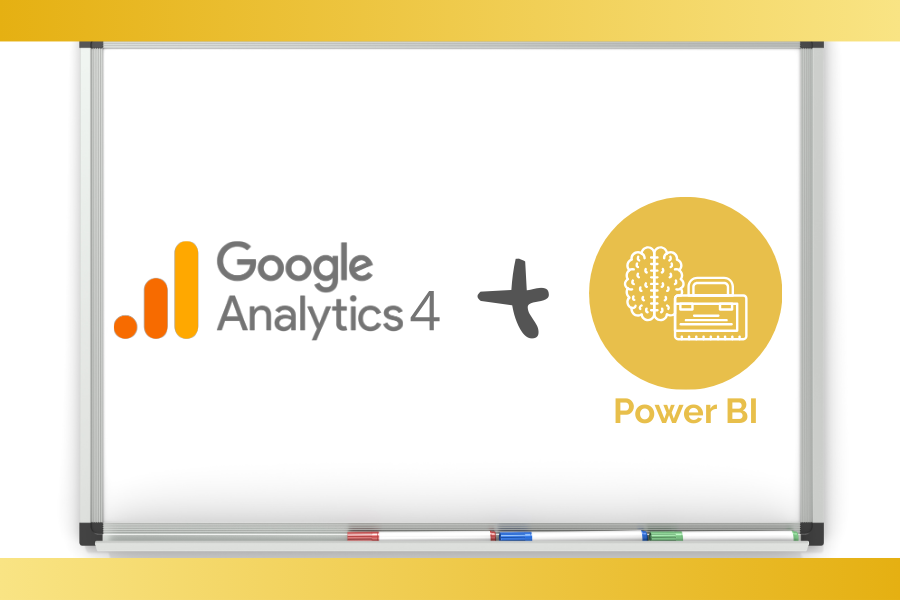And that’s exactly where Power BI comes in. It’s a tool that not only displays data from GA but also lets you combine it with other sources — like your CRM, sales system, email campaign data, or social media performance. As a result, you stop guessing and start seeing the full story: from the first ad click all the way to the invoice.
Google Analytics + Power BI = real analysis, not just stats
Have you ever felt like the data from Google Analytics is a bit… underwhelming? You know how many people visited your site, where they came from, how long they stayed, and what they clicked on — but you still can’t tell whether any of it is actually helping your business.
Because GA, powerful as it is, only shows one piece of the puzzle. It’s great for analyzing traffic, but when you want deeper insights — like whether users from Campaign X actually became customers, or which content attracts the highest-value leads — that’s when it starts to fall short.
And that’s exactly where Power BI steps in.
Power BI lets you combine Google Analytics data with other sources — your CRM, sales system, Excel sheets, or email campaign data. This way, you’re not just tracking traffic; you’re understanding how marketing activity translates into real business outcomes.
It’s no longer just “a nice chart from GA.” It’s analysis that answers questions that really matter.
Which Google Analytics data is worth analyzing in Power BI?
You know that feeling when you look at Google Analytics and see traffic going up? Organic, paid — it all looks promising. But… something’s off. There are no conversions. Or there are, but they’re not turning into actual sales.
So here’s the real question: do traffic stats alone tell us anything meaningful about the effectiveness of marketing?
Google Analytics gives you plenty — but only when you connect it with other sources in Power BI can you see what’s actually working, and what’s just generating empty clicks.
Here’s what’s really worth analyzing:
- Organic vs. paid traffic – and their true impact – sometimes SEO brings in the highest-quality leads. Other times, it’s a Meta Ads campaign driving actual sales — even if the GA stats don’t look that impressive. With Power BI, you can match Google Analytics traffic data with results from your CRM or invoicing system and find out which channel is really delivering offline conversions.
- User behavior vs. the sales process – are people who visit a specific landing page more likely to convert? Does time on site correlate with average order value? With Power BI, you can analyze user journeys from GA in the context of later sales stages — and stop relying on guesswork.
- Marketing campaigns vs. CRM results – not every high-CTR campaign ends in a sale. Power BI lets you compare data from Google Analytics (like Google Ads or Meta Ads) with actual sales results. This way, you can quickly spot campaigns that just look good — and the ones that truly perform.
Why companies using Power BI gain a competitive edge
Do you ever feel like the more data you have, the harder it is to make sense of it? Your CRM says one thing, your e-commerce platform another, and your email tool something else entirely — and you’re stuck juggling five different reports, trying to piece together one coherent story.
Enter Power BI — your data superhero in white.
Instead of juggling Excel files and screenshotting GA dashboards, you get a single, integrated view of your data. CRM, e-commerce, email marketing, social media — all combined in one dashboard. For marketing, sales, and management alike.
Different systems? Power BI connects them all
Power BI lets you connect data from CRM tools, online stores, mailing platforms, Google Ads, Meta Ads — basically any tool with an API or even just Excel export. No more manually aligning data from different sources. You just connect them. And analyze.
One dashboard – multiple perspectives
Each department sees data differently. Marketing wants to know customer acquisition cost, sales looks at conversion rates, while management focuses on revenue growth. With Power BI, you can create customized reports for each audience — all powered by the same data set.
No discrepancies. No confusion. Just one source of truth.
Data-driven decisions, not gut feelings
You’ve heard it before: “I’ve got a feeling this campaign worked best.” And then… the data tells a different story. Power BI helps you base decisions on facts — not intuition. And that’s an advantage that’s hard to beat.
Typical use cases: Google Analytics + Power BI in action
Imagine you’re a marketing manager. You’re responsible for campaigns, lead targets… and then someone in sales says: “Another batch of low-quality leads. Nothing will come of it.” Sound familiar?
That’s why connecting Google Analytics to Power BI makes such a difference. You can not only show which campaigns are bringing in leads — but which ones actually matter.
Because not all leads are equal. One visitor might click and disappear. Another might leave a contact, talk to your sales team, and make a purchase. Power BI shows you which campaigns are generating those high-quality leads.
And now over to the sales team. Reps want to know which digital activities are bringing in quality contacts. They’re tired of cold calling with no context. In Power BI dashboard, they can see exact user paths that led to calls, demos, or purchases. Finally, they know what actually works — not just what looks good in GA.
And then there’s management. They don’t want three Excel files and five conflicting versions of the truth. They want one report that clearly shows:
- where the traffic came from,
- how many leads were generated,
- and how much revenue it produced.
One dashboard. One version of the data. One language for marketing, sales, and leadership.
Marketing and sales aligned by data
Combining Google Analytics and Power BI isn’t just a technical integration. It’s about:
- a cohesive view of both online and offline performance,
- better communication across departments,
- and less time wasted on reporting and explaining “what this number really means.”
Because once you build a solid Power BI dashboard, there are no more “Do you have different numbers?”, “Where did this data come from?”, or “Can you show that table again?”
Want to make the most of your Google Analytics data in Power BI?
We’ll create dashboards and show you how to analyze them in the context of sales and business growth.
👉 Contact us to learn more

